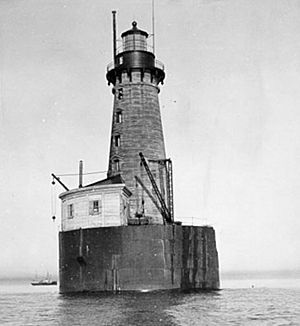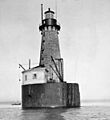Stannard Rock Light facts for kids
 |
|
| Stannard Rock Light | |
|
|
|
| Location | Off Keweenaw Peninsula in Lake Superior |
|---|---|
| Coordinates | 47°11′0.62″N 87°13′30.42″W / 47.1835056°N 87.2251167°W |
| Year first constructed | 1883 |
| Year first lit | 1883 |
| Automated | 1962 |
| Foundation | Crib |
| Construction | Dressed stone, Monolithic limestone/iron bolts. |
| Tower shape | Frustum of a cone tower on cylindrical crib |
| Markings / pattern | Natural with black lantern |
| Height | 100 feet (30 m) |
| Focal height | 102 feet (31 m) |
| Original lens | - 3rd order Fresnel Lens |
| Current lens | Solar powered 12-inch (300 mm) Tideland Signal ML-300 acrylic lens |
| Intensity | 3,000 candlepower |
| Range | 18 nautical miles (33 km; 21 mi) |
| Characteristic | Flashing, white, 6 sec |
| Fog signal | Air diaphone (originally steam whistle) |
| ARLHS number | 808 |
| USCG number | 7-14725 |
The Stannard Rock Light is a famous lighthouse in Lake Superior. It was finished in 1883. This lighthouse sits on a dangerous underwater rock formation called a reef. This reef was the biggest danger for ships sailing on Lake Superior.
The base of the Stannard Rock Light is a special structure called a "crib." Experts say building this crib was one of the top ten amazing engineering achievements in the United States. The lighthouse is about 24 miles (39 km) from the nearest land. This makes it the farthest lighthouse from shore in the entire United States.
It was once called a "stag station." This meant only men worked there, without their families. Because it was so far out, it earned the nickname "The Loneliest Place in the World." The lighthouse became automatic in 1962. The United States Coast Guard still uses it to help guide ships today. You can only see it by boat or airplane. It is not open for people to visit. The lighthouse was added to the National Register of Historic Places in 1971.
Contents
Discovering Stannard Rock Reef
The Stannard Rock Reef is located near the Keweenaw Peninsula. It is about 24 miles (39 km) south of Manitou Island. It is also about 44 miles (71 km) north of Marquette, Michigan. In 1835, Captain Charles C. Stannard found this underwater mountain. He was sailing his ship, the John Jacob Astor.
The reef stretches for about 0.25 miles (0.40 km). Some parts are only 4 feet (1.2 m) deep, while others average 16 feet (4.9 m). This shallow reef was very dangerous for ships. In 1868, a day beacon was placed there to warn sailors. People also tested if a lighthouse could survive in such a harsh spot. A temporary marker was put there in 1866.
After the Soo Locks opened, more ships traveled between Duluth, Minnesota, and the lower Great Lakes. This made building a lighthouse very important. The lighthouse was named after Captain Stannard. The Stannard Rock Light is known for being the farthest lighthouse from shore in the U.S.
The Stannard Rock Reef is also a great place for fishing. It is home to many lake trout. Michigan's record for lake trout was caught here. A 16-year-old named Lucas Lanczy caught a 61-pound, 8-ounce (27.9 kg) lake trout in 1997.
Building the Lighthouse
Building the Stannard Rock Light was a huge challenge. It was very far out in Lake Superior. Orlando Metcalfe Poe from the Lighthouse Board found a solution. He used the same tools and methods that built the Spectacle Reef Light on Lake Huron. This included a steam-powered cement mixer. It also had a machine to shape wood.
Work on the remote reef could only happen from May to October. Many days were lost because of bad weather. All the equipment from Spectacle Reef Light was moved to Huron Bay. This was where the base, or "crib," for Stannard Rock Light was built. Construction of the crib started in July 1877.
Large stone blocks were cut in Marblehead, Ohio. They were then shipped to the site. In August 1877, the crib was taken to Stannard Rock. Workers checked the reef to make sure the crib would fit. The crib was then brought back to Huron Bay. More layers were added to it.
In August 1878, the crib was finally placed on the reef. By October 1878, it was filled with concrete and stone. The stone came from a quarry on Huron Island. By June 1879, an iron pier was built up to the water's surface. By mid-1880, the structure was 14 feet (4.3 m) above the water.
The tower was finished, and the light first shone on July 4, 1882. Work on the tower continued until 1883. It took five years to build the Stannard Rock Light. It cost $305,000, which was close to the original plan. A lot of materials were used:
- 126 tons (114 t) of iron
- 76 tons (69 t) of brick
- 1,270 tons (1,150 t) of tower stone
- 7,276 tons (6,600 t) of concrete
The base of the Stannard Rock Light is considered one of the top ten engineering achievements in the United States. This lighthouse is often called the most exposed lighthouse on the Great Lakes.
Life at the Lighthouse
Winters on Lake Superior were very harsh for the Stannard Rock Light keepers. Waves would splash against the tower. This created thick layers of ice. Maintenance crews had to chop away the ice just to reach the entrance. If someone got sick, had an accident, or there was a fire, help could take days or weeks to arrive.
Because it was so isolated, Stannard Rock was a "stag station." This meant only men could work there. The keepers called it "The Loneliest Place in the World." It was known as the loneliest spot in the entire United States. One historian, Wes Oleszwski, reported how tough the duty was. In the first three years, four keepers quit and three asked to be moved.
Lighthouse keepers left Stannard Rock in early December when shipping season ended. The towers were locked until they returned in March. Getting to the lighthouse was always hard. At the start of the season, keepers often used sledgehammers and pickaxes. They had to clear 1 to 2 feet (0.30 to 0.61 m) of ice from the door, lantern, and foghorns.
For 60 years, the keepers used flammable liquids to power the light and heat their living areas. The lighthouse did not get electricity until after World War II. A few years later, a serious accident happened. Gasoline and propane tanks exploded. This destroyed buildings on the pier. It also badly damaged the inside of the tower.
One keeper died in the explosion. Three others were stuck on the concrete pier for three days. A passing ship finally saw them and told the Coast Guard. The men were rescued by the tender Woodrush.
After the accident, the Coast Guard fixed the fire damage. They decided the location was too dangerous and remote. So, they made the station automatic in 1962. The very bright 1,400,000 candlepower light was replaced. A smaller 3,000 candlepower light was installed.
The Coast Guard carefully took apart the old Fresnel lens. This lens had 12 special "bulls-eyes." They carried it down 141 tower stairs. It was packed into six wooden crates. Then, they lowered the crates 80 feet (24 m) to the base for shipping.
Years later, the Fresnel lens was found. It was in a storage warehouse at the United States Coast Guard Academy in New London, Connecticut. This was 37 years after it was removed! The base of the lens was moved to a museum in 2000. Today, you can see the lens at the Marquette Maritime Museum. You can also learn more at the Marquette Harbor Light.
New Purpose and Current Status
The Stannard Rock Light is still owned by the Coast Guard. It continues to be an active aid for ships. You can only see the lighthouse from an airplane or boat. It is not open to the public.
For over a century, the lighthouse warned sailors away from the dangerous reef. In 2008, it got a new job. Scientists put equipment on top of the tower. They wanted to measure if more water was evaporating from the Great Lakes. This could be why water levels were getting lower.
Boat trips are available to see the lighthouse up close. However, visitors are not allowed to go inside.
Images for kids



